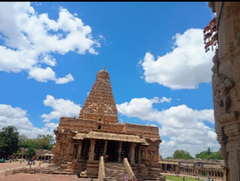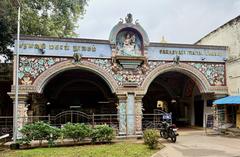
Thanjavur Varadaraja Perumal Temple: Visiting Hours, Tickets, History, and Travel Guide
Date: 04/07/2025
Introduction
The Varadaraja Perumal Temple in Thanjavur is a living testament to South Indian devotional traditions and the architectural grandeur of the Chola dynasty. Dedicated to Lord Vishnu as Varadaraja Perumal, the “King who bestows boons,” this temple encapsulates centuries of spiritual practice, attracting devotees, historians, and travelers alike. Though less renowned than its Kanchipuram counterpart or the nearby Brihadeeswarar Temple, it holds immense religious and cultural significance, particularly for those born under the Jyestha nakshatra. Visitors can experience ancient rituals, vibrant festivals, and the artistry of Dravidian temple design, all while exploring one of Tamil Nadu’s most spiritually resonant sites (TN Temples Project; TempleYatri; Bhaktikalpa).
Contents
- Historical Background and Religious Significance
- Origins and Dynastic Patronage
- Ritual Practices and Community Role
- Architectural Features and Symbolism
- Festivals and Ritual Calendar
- Visiting Information
- Hours, Tickets, and Accessibility
- Dress Code and Visitor Etiquette
- Facilities and Travel Tips
- Nearby Attractions
- Frequently Asked Questions (FAQ)
- Conclusion
- References
Historical Background and Religious Significance
Origins and Dynastic Patronage
The Varadaraja Perumal Temple’s origins trace back to the later Chola period (11th–13th centuries CE), an era when Thanjavur flourished as a hub of temple architecture and religious scholarship. The temple’s west-facing sanctum is a rare feature among Vishnu temples, reflecting unique local traditions. Over successive centuries, the Cholas, Nayaks, and Marathas contributed to the temple’s growth, as evidenced by inscriptions detailing endowments and renovations.
The principal deity, Varadaraja Perumal, stands in the central sanctum with consorts Sridevi and Bhudevi—a classic Chola iconographic motif. The temple’s structure, including its vimana, prakaram, and numerous mandapams, reveals the enduring influence of Dravidian architectural principles.
Ritual Practices and Community Role
Varadaraja Perumal symbolizes Vishnu’s benevolence and protection. Daily worship follows agamic traditions, with resident priests conducting morning and evening rituals. The temple serves as a spiritual nucleus for the local community, hosting life-cycle ceremonies and annual festivals that foster communal harmony.
Legends connect the temple to pan-Indian myths, such as Brahma’s yagna and Vishnu’s boon-giving, and its collection of sacred icons from defunct shrines underscores its role as a preserver of regional religious heritage (Bharat Ke Wow).
Architectural Features and Symbolism
- Layout & Orientation: The temple follows agamic principles, with a sanctum (garbhagriha) facing west, surrounded by subsidiary shrines, pillared halls (mandapams), and a sacred water tank (Anantha Theertham) (TempleYatri).
- Gopuram (Gateway Tower): The multi-tiered gopuram, adorned with stucco figures and mythological motifs, marks the entrance.
- Mandapams: The famed 100-pillared hall features intricately carved granite columns depicting mythological scenes and floral patterns, providing space for festivals and gatherings.
- Sanctum & Vimana: The main deity resides in a windowless sanctum, with a pyramidal vimana above, symbolizing the spiritual ascent toward the divine.
- Subsidiary Shrines: Dedicated to Perundevi Thayar (Lakshmi), Garuda, and Vaishnavite saints, these shrines are adorned with unique vimanas and bronze icons (Gosthala).
- Sculptures & Decor: The temple’s walls and pillars depict episodes from the Ramayana and Mahabharata, as well as intricate floral and geometric designs.
- Materials & Construction: Built primarily from granite with traditional joinery; corbelled arches and stone beams showcase the craftsmanship of medieval South India.
Festivals and Ritual Calendar
Major Festivals
- Margazhi Kettai (Dec–Jan): Celebrated during the Tamil month of Margazhi, this festival is especially significant for those born under the Jyestha nakshatra. Ritual baths (abhishekam), lamp offerings, and special poojas are performed (Bhaktikalpa).
- Purattasi Saturdays (Sep–Oct): Saturdays in the Purattasi month are marked by special decorations, devotional music, and sweet offerings.
- Periya Nambi’s Birth Star Day: Honors the guru of Ramanuja with unique lamp-lighting rituals using a blend of three sacred herbs.
Ritual Practices
- Nakshatra Worship: The temple is famed as the “Jyestha Nakshatra Temple.” Devotees visit on their birth star days, especially Tuesdays, for spiritual upliftment and karmic relief (Bhaktikalpa).
- Healing Rituals: Special prayers are offered for eye ailments and removal of obstacles, involving abhishekam, archana, and lamp lighting.
- Unique Offerings: Rituals include lighting lamps with herbal oils, burning rattan incense, and worshipping the neem tree, which is associated with the Jyestha star (FindYourFate).
Visiting Information
Hours and Entry
- General Timings: 6:00 AM–12:00 PM and 4:00 PM–8:00 PM daily. During festivals or nakshatra days, hours may be extended (FindYourFate).
- Pasupathikoil Branch: 7:00 AM–9:00 AM and 5:30 PM–7:30 PM.
- Tickets: Entry is free for all visitors. Donations are voluntary and support temple upkeep.
- Special Rituals: Participation in abhishekam or special poojas may require advance arrangements with the temple office.
How to Reach
- By Air: Nearest airport is Tiruchirappalli International (60 km away).
- By Train: Thanjavur Railway Station is well connected, with auto-rickshaws and taxis available.
- By Road: Accessible via national highways and local buses.
Dress Code and Etiquette
- Modest, preferably traditional attire: dhotis or trousers with shirts for men; sarees or salwar kameez for women.
- White garments are auspicious for offerings.
- Footwear must be left outside.
- Photography is permitted in outer areas; not inside the sanctum.
Facilities and Accessibility
- Basic amenities like drinking water and restrooms are provided.
- The temple is moderately accessible; those with mobility issues may require assistance due to steps at the entrance.
- During festivals, temporary stalls offer snacks and prasad.
Travel Tips
- Visit in early morning or late evening for a serene experience.
- Plan ahead during major festivals for accommodation and transport.
- Hire local guides for deeper insights into history and rituals.
Nearby Attractions
- Brihadeeswarar Temple: UNESCO World Heritage Site with magnificent Chola architecture.
- Thanjavur Maratha Palace: Home to the Saraswathi Mahal Library and art gallery.
- Ramaswamy Temple, Alangudi Guru Temple, Swamimalai Murugan Temple: Notable for their religious and architectural significance.
- Darasuram, Kumbakonam, Gangaikonda Cholapuram: Other important temple towns nearby.
For a comprehensive list, see Tour My India and Capture A Trip.
Frequently Asked Questions (FAQ)
Q1: What are the temple’s visiting hours?
A: The main temple is open from 6:00 AM to 12:00 PM and 4:00 PM to 8:00 PM; Pasupathikoil branch from 7:00 AM to 9:00 AM and 5:30 PM to 7:30 PM.
Q2: Is there an entry fee?
A: No, entry is free. Donations are welcome.
Q3: Can I participate in rituals?
A: Yes, especially on nakshatra days and during major festivals.
Q4: Is the temple accessible for differently-abled visitors?
A: Some steps are present; assistance may be needed. Basic amenities are available.
Q5: Are guided tours available?
A: Local guides can be hired; inquire at the temple office or through travel agencies.
Q6: What are the photography rules?
A: Allowed in the temple courtyard; restricted inside the sanctum.
Conclusion
The Varadaraja Perumal Temple in Thanjavur is an architectural jewel and spiritual sanctuary, offering visitors a deep connection to Tamil Nadu’s devotional heritage. Its unique blend of Chola artistry, vibrant festivals, and living ritual traditions make it a must-visit for devotees, historians, and travelers alike. Plan your visit around major festivals for an immersive experience, adhere to temple etiquette, and explore nearby attractions to enrich your journey.
For more information, visit these resources:
Ready to explore Thanjavur?
Download the Audiala app for guided audio tours, interactive maps, and exclusive tips to enrich your visit to Varadaraja Perumal Temple and beyond. Follow us on social media for updates and travel inspiration.



